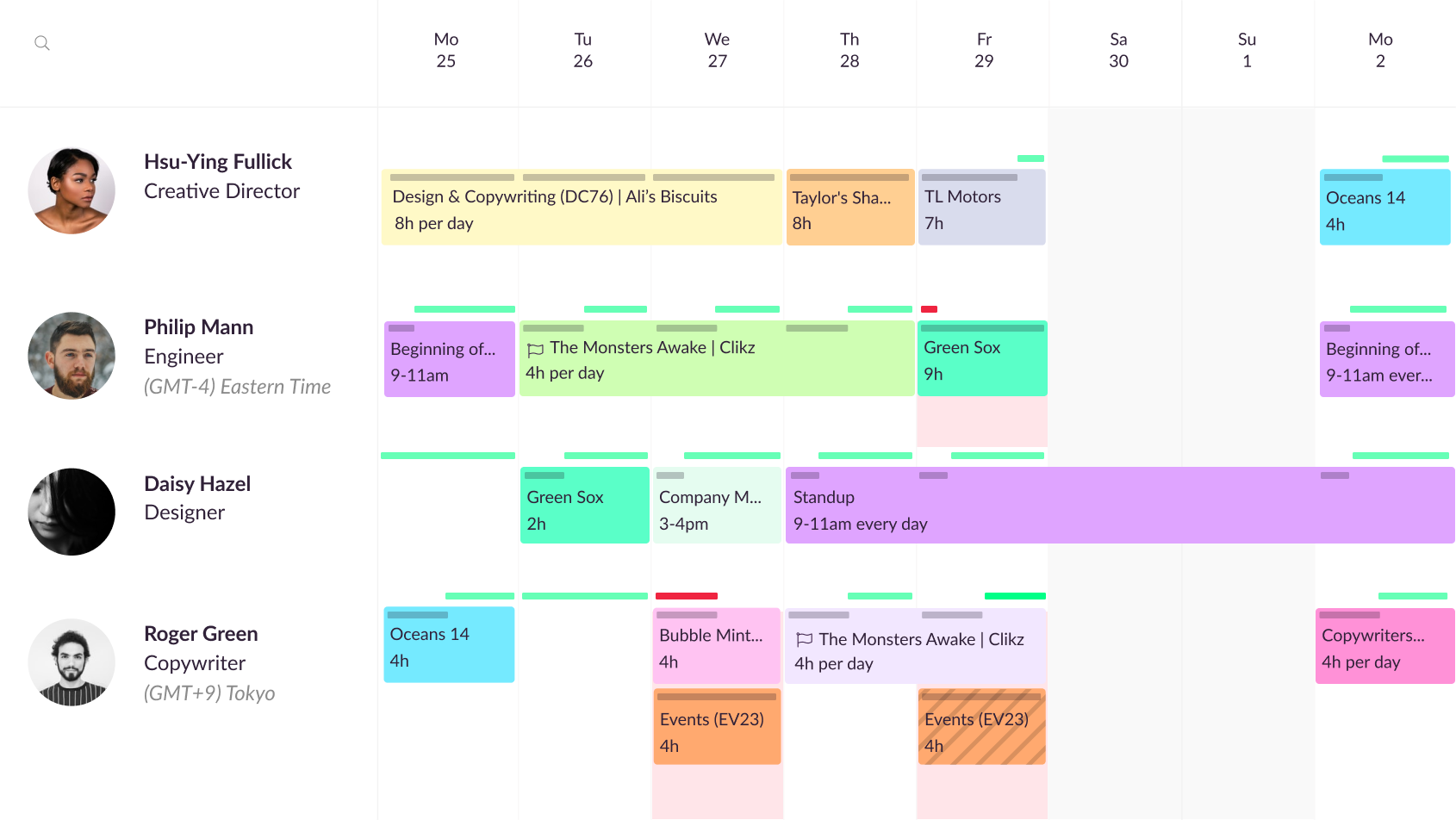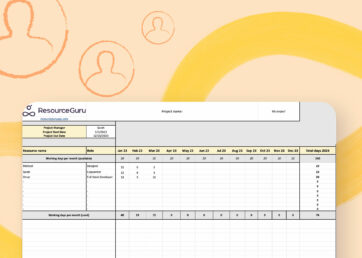If you’ve ever played Tetris, made a few miscalculations, and watched the shapes rapidly stack up to the top while you struggle to keep up, you’ve had a taste of what happens when a business uses ineffective resource management. Except, instead of squares on a screen piling up, real people feel over-scheduled and under-supported.
While your goal is to have each person complete their piece of the project at the right time, things can get pretty backed up and unorganized without a strong resource management system in place.
Resource planning is an artful science and often one of the biggest challenges in busy companies with limited resources. If “on time and on budget” is one of your mantras, you need a detailed plan to allocate and manage resources as effectively as possible.
This plan is where resource scheduling comes in. Resource scheduling plans are about having the right resources available for the right tasks at the right time. Sound simple enough? Sure, but in practice, it’s an area that is often rife with pitfalls for project managers.
In this guide, you’ll learn about what resource scheduling is, which key challenges are associated with the process, and how to implement your resource scheduling successfully.
In this article 📖
What is resource scheduling?
Resource scheduling is the process of identifying exactly which resources you need and scheduling exactly when you need them.
In project management, your resources are your people. Each person plays their part in completing the tasks that make up your project. You need those people at the right times to keep your project on-track.
The art to resource scheduling is that it should be based on your resource’s availability and capabilities. You don’t want to over or under-schedule your valuable resources, nor do you want to have to resort to assigning tasks to those without a strong capability for them.
A strong resource scheduling process will help you to:
- Optimize the schedules of all of your resources.
- Allow some leeway in case of any hold-ups.
- Monitor project progress more easily.
- Assign the right people to the right task.
- Assess any delays and re-shuffle resources, tasks, or deadlines for maximum efficiency.
- Realize when resources could be better used and reassign tasks accordingly.
Bigger projects with several moving parts require an advanced resource scheduling plan to organize those resources optimally. Project managers often try to coordinate with various departments that own the resources, and resource managers may have to accommodate different requests. A robust resource scheduling solution helps managers tie all of these moving parts together and create a clear picture of what is needed.
What are the main challenges in current resource scheduling techniques?
Have you ever looked at your over-scheduled calendar and wondered how you got there? If you are a “resource to be scheduled,” the state of your messy calendar is often a direct complication of poor resource scheduling. One of the main reasons this continues to happen in companies is because project managers are still relying on traditional resource scheduling methods, which aren’t the most efficient in today’s work environment.
One of the most common traditional techniques for project managers is the good old Excel spreadsheet. Project managers adhering to this system historically relied on spreadsheets because of their low maintenance costs, adaptability, and relatively simple setup. Unfortunately, projects that are riddled with contingencies, different time zone constraints, and complex requirements can’t rely on spreadsheets like small projects can.
Spreadsheets are prone to some common issues. For example, version control can become tricky when more than one person makes updates, or when someone forgets to make an update. Resource scheduling can suffer when critical changes to availability aren’t updated on the spreadsheet or synced across the team.
Another problem with spreadsheets is that they’re not built to manage complex calendars. They might hold the data (as long as the spreadsheet is up-to-date), but the project manager then has to identify scheduling clashes or inefficiencies. On larger projects, these problems can be a major time-sink for the project manager.
Shared calendars are another method that is often used for resource scheduling. But anyone who’s tried to do that with more than about 5 people understands why it’s not a scalable solution. The other problem with calendars is you have to specify working hours. Often you don’t want to do this. It’s much easier to add a duration eg 4 hours and allow people to manage their own time.
Alternatively, maybe you’re using a dedicated project management tool for your complex project, but as with so many of them, yours is rooted in task-based functionality. For example, many companies rely on Gantt charts for project timelines, which are great for organizing tasks, but often fail to take resource availability into consideration. You can soon run into issues when scheduling is not a priority of your system.
When resource scheduling is messy, you get:
- Expensive, delayed project outcomes. A person who is over-scheduled will have a natural limit for how much work they can handle. Going over that limit can often snowball into missed deadlines. If you have tasks with dependency delays, the whole project plan can go sideways.
- Awkward conversations with project sponsors. It’s your reputation on the line when you can’t deliver on time and within budget, and doing anything but might cost you a client.
- Tired, overworked team members (or the opposite: bored, under-utilized team members!). In either case, poor resource scheduling can lead to low morale, mistakes, lack of engagement, and high employee turnover. For example, did you know your employees are more likely to look for a new job because they are bored rather than because they want a higher salary?
- Conflict at work. When Kat is known as the best there is for writing campaign headlines, naturally, everyone wants her for their project. If resource scheduling isn’t handled carefully, Kat ends up booked into evenings and holidays, while competing project managers want to know why she isn’t always available for their project. There can be a lack of cohesion and understanding across departments or projects.
Benefits of having an effective project resource scheduling system
By now you’ve probably gathered that the traditional methods of resource scheduling just don’t stand up to contemporary scrutiny. With that said, a resource scheduling system with complex projects in mind can bring many critical benefits. For example:
- You can ensure the timely (and budget-conscious) delivery of projects because you know exactly where all your resources spend their time. Tasks can be executed at the right time and you avoid project delays.
- Project quality is better. People tend to give their best, but as the saying goes, you can’t pour from an empty vessel. Proper scheduling ensures your resources aren’t overbooked and are free to do their best work.
- You get better visibility and accountability over scheduling. Your system can help you to accurately forecast demand and ensure that you have availability of resources. Organization-wide, there is better visibility over who is scheduled, when, and where.
- You can leverage your resources better. When everyone is scheduled for optimal utilization rates, you can often accomplish more with fewer resources. A robust scheduling system makes it easier to prioritize your resources.
- You can often reduce project costs. An optimized resource scheduling system allows you to budget with a better level of accuracy and track critical financial data throughout. You can take proactive steps to reduce costs ahead of time.
Resource scheduling in 5 steps
How do you ensure you’re effectively scheduling resources? Here are some steps to follow:
Step 1: Choose your resource scheduling tool
All resource scheduling should be documented (or it didn’t happen!). To do this, you need to choose the right tool that will help you to plan ahead and manage resources as efficiently as possible. Which tool will suit your business?
Take a look at Resource Guru. We built our software to master your team’s time. For example, our simple drag and drop interface allows you to easily rebalance workloads from the bird’s eye view calendar.

However, we recognize that not everyone is ready to take that step – if this sounds like you, we have a free resource scheduling template for Excel that you can download.
Step 2: Break down all of your project tasks
Tasks, both big and small, make up a project. A good starting point for resource scheduling is to break the project up into individual tasks.
This breakdown allows you to look at the scale of the activities and estimate your resource needs. Who do you need for each of these tasks and how long will it take them?
Make sure you get some input from those who do the tasks when you estimate timing. Sometimes it can help to use time tracking to gauge how long tasks usually take. After all, paying for the time of resources goes into the budget estimate.
Step 3: Identify resource availability and capability
Anyone being assigned a task needs both the time to do it and the skills required. Do you have people available internally for all of your key tasks? Or, will you need to bring on contractors or freelancers?
If Kathy in IT is in so much demand for her script-writing prowess, you may find she’s fully booked, while others who don’t have the skill set are free. This kind of situation is when you seek out alternatives to ensure you have the skills available to keep the project on-track.
Step 4: Create your resource schedule
Allocate tasks, deadlines, and dependencies for those tasks. Scheduling will be based on the availability of your team.
Project managers need to be able to provide accurate estimates of when things will be done to their stakeholders. You need an overview of where in the lifecycle of the project certain critical tasks will be needed and when the people with those skills will be available. Resource Guru has a great reporting feature that helps project managers to accurately make their estimates.
Step 5: Monitor, track, and manage resources
With your resources in place and the project underway, managing, tracking, and monitoring are key to ensure continual successful resource scheduling. Track your project’s progress and make sure it is where it should be.
You also need to check in with your project resources to ensure there are no clashes that might impact scheduling. What if someone is out sick? Or, what if they had booked vacation time somewhere in the middle of the project timeline?
To better your estimates for future projects, track how long tasks take as compared to what you estimated.


“Resource Guru has the perfect balance of simplicity and detail. It’s easy to see where issues might arise.”
Resource Scheduling Guide – Key Takeaways
Resource scheduling is a key part of effective project management. It’s not enough to just manage tasks or create a nice-looking Gantt chart, you need to have a grasp of the time and resources required for those tasks.
In fact, we’d go as far as saying resource scheduling is one of the most important indicators of a successful (on time and within budget) project. The bottom line is resources are people, and it’s your people who create the success of the project.
Every project manager should have access to the best resource scheduling software, and for that, there’s us. Check out how we can help you to schedule resources more effectively.






